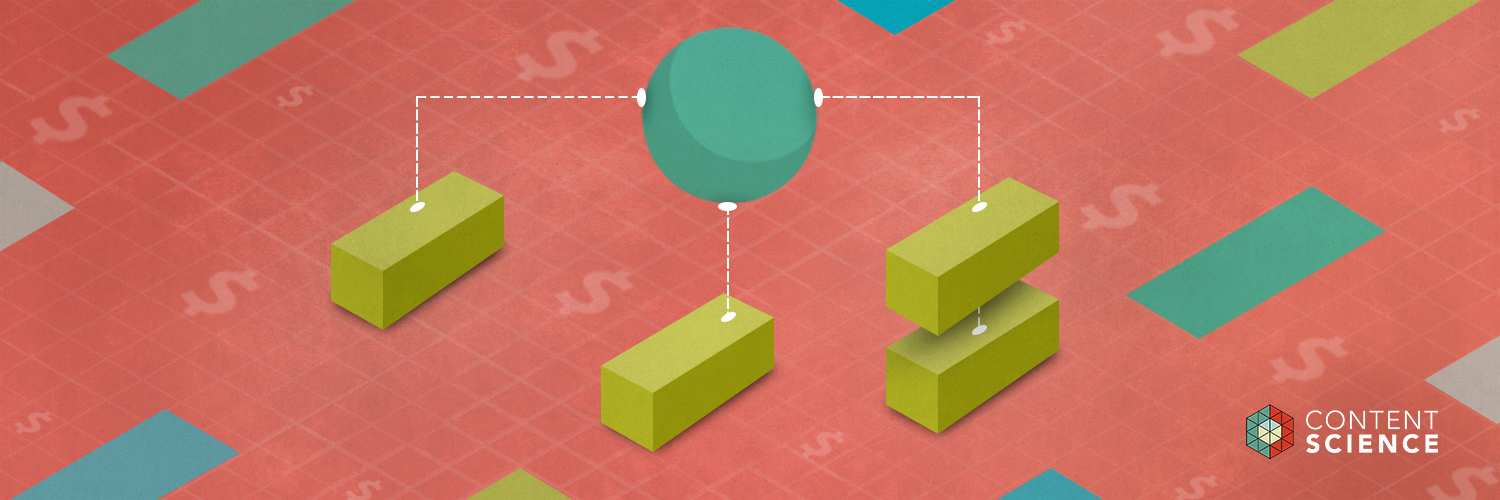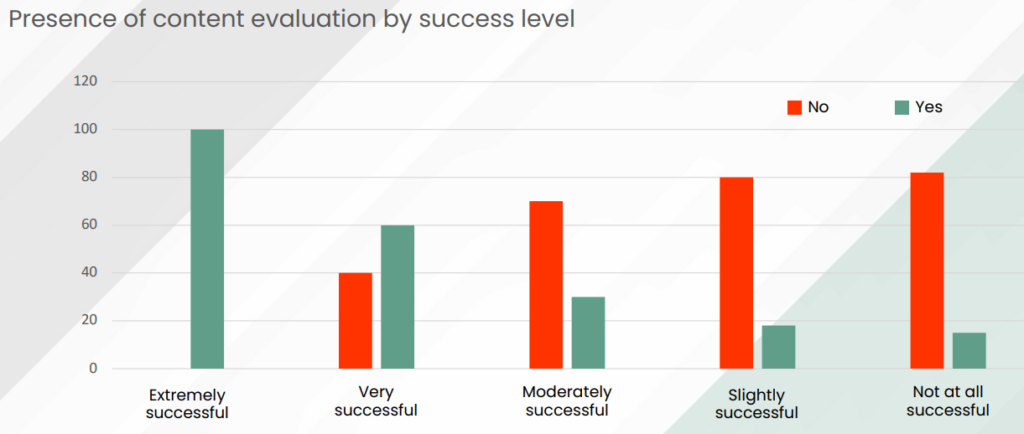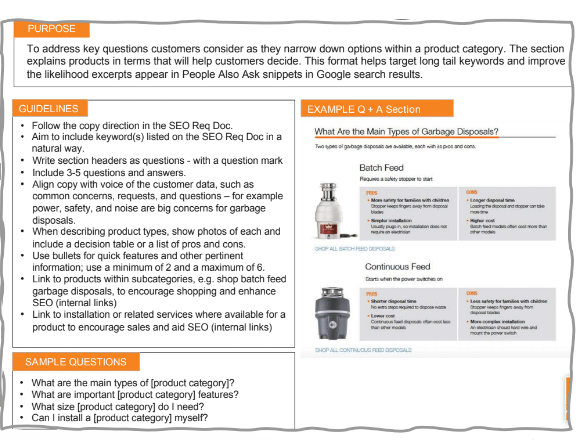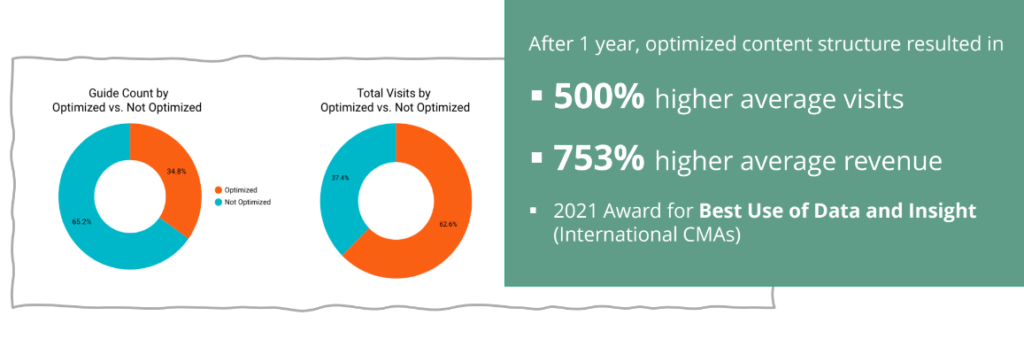
The short answer to this question is “yes.” As for the long answer, I shared it with an enthusiastic virtual and in-person group at Structured Content 2022, the first conference dedicated to the power of structured content, and am excited to share them with you here. Let’s look at why content measurement and content structure should go hand in hand, based on Content Science’s recent award-winning work in content data and insight.
The Most Successful Organizations Measure Content Effectiveness
Our Content Operations Study identified five levels of organizational maturity. Most organizations are at level 1 or 2. Only 2% fall into the level 5 category. But all of those organizations regularly evaluate content effectiveness.

regularly evaluating content
The cool thing here is that adding structure to content makes measuring it more efficient, meaningful, and actionable. Let’s walk through a few ways to make that happen.
1. Adding Tags to Make Reporting More Efficient
A simple way to add structure to content is to add tags. You’re probably familiar with adding tags to make content easier to find in the user experience. Tags also can help make your reporting of measurements much more efficient to assemble and understand.
For instance, we recently worked with a large home improvement retailer that was in the early stages of optimizing its content for search visibility and business impact. They were not new to content, and had more than 1,000 existing DIY articles, but without much structure. We applied a set of tags such as guide type or optimization status to enable more useful breakdowns.
So let’s look at another way content measurement and content structure multiply the benefits to you.
2. Using Measurement to Identify the Best Content Structure
Measuring content can help you identify what sets apart the most impactful content–including what structural characteristics.
What data should you use to measure? Our Content Operations Study found that the most successful organizations used more diverse data to measure their content effectiveness. Going back to our home improvement example, we considered data like organic search visits, attributed revenue, and customer feedback about content that we could slice and dice to create a benchmark. We also conducted a large scale evaluation with more than 1,000 customers using our ContentWRX tool.
We conducted deep analysis to identify correlations between content characteristics (What combination of sections? How many images? How much text in which sections?) and performance, including but not limited to
- Content structure and organic search traffic.
- Content structure and attributed revenue.
Once we identified what structure was working best, we turned that insight into standards. Let’s take a closer look.
3. Optimizing Content Structure with Standards
When you know what works well about your content structure, you can standardize it. Looking at the home improvement retail example again, we dubbed these standards “Best in Class” and codified them in documentation. We noted changes to templates, requirements, and processes.

The retailer used the documentation with a variety of internal teams to implement changes so that more content followed the standards.
Now, let’s turn to one more way content measurement and content structure combine into a powerful force.
4. Evaluating Content Impact + Connecting to ROI
When you have a solid approach to measurement in place, you can then keep evaluating content effectiveness over time. (We sometimes call this a system of content intelligence.) We often see that the results from improving and maintaining content structure are like compounding interest, and content measurement allows you to prove the phenomenon.
In the case of the home improvement retailer, the changes to content structure yielded big results in two areas. The first was in search visibility. Previously, a small percentage of guides accounted for the majority of traffic and revenue, and conversely, the majority produced little to no revenue. Just three months in, we could already see that DIY guides following the “best in class” standards had an outsized impact on organic site traffic, to the tune of 213% higher average visits. And after a year, these guides resulted in 500% higher average site visits.
The second area of compounding results was revenue. After three months, these resulted in 244% higher revenue. And by the year end, the results snowballed into 753% higher average revenue.

So, adding even a little data to inform content structure can not only improve the content’s effectiveness but also show compounding content results.
We covered a lot of ground here, so let’s do a quick recap. Content structure and content measurement can create a virtuous cycle of awesome results.
- Add structure as simple as tags to make measuring your content’s performance more efficient.
- Use the more meaningful measurement to identify the characteristics of content structure working most effectively and then standardize them.
- Keep measuring the impact to confirm improvement and continue to optimize.
Then watch the miracle of compounding content results unfold.
Events, Resources, + More
New Data: Content Ops + AI
Get the latest report from the world's largest study of content operations. Benchmarks, success factors, commentary, + more!
The Ultimate Guide to End-to-End Content
Discover why + how an end-to-end approach is critical in the age of AI with this comprehensive white paper.
The Content Advantage Book
The much-anticipated third edition of the highly rated book by Colleen Jones is available at book retailers worldwide. Learn more!
20 Signs of a Content Problem in a High-Stakes Initiative
Use this white paper to diagnose the problem so you can achieve the right solution faster.






Comments
We invite you to share your perspective in a constructive way. To comment, please sign in or register. Our moderating team will review all comments and may edit them for clarity. Our team also may delete comments that are off-topic or disrespectful. All postings become the property of
Content Science Review.